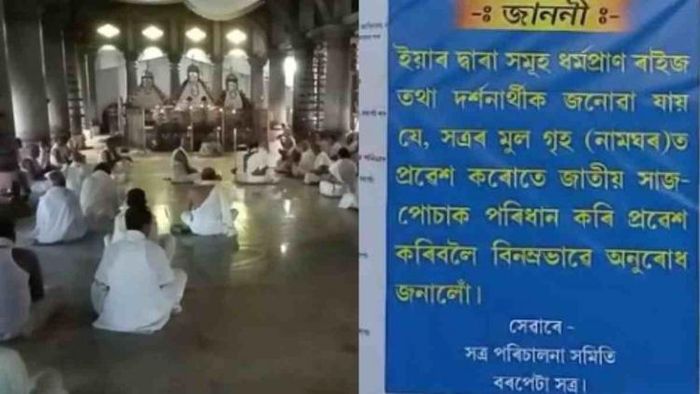Assam: Barpeta Satra Committee urges devotees to wear traditional attire while visiting Kirtanghar
The Doul Jatra or Deol is an annual religious celebration observed in Barpeta Kirtan Ghar. It coincides with the Holi celebration. It has a strong hold over the Barpetans

- Sep 11, 2022,
- Updated Sep 11, 2022, 6:58 PM IST
The Satra Managing Committee is attempting to preserve the Sattriya heritage of Barpeta Satra by encouraging worshippers to wear traditional attire while visiting Barpeta Satra's main kirtanghar. Although the Satra Committee has not made traditional attire mandatory, it has decided to make a request in order to preserve Satra's dignity and traditions.
The secretary of the satra managing committee stated that if any devotee/visitor desires, the satra managing committee will offer the dress at the time of entry into the satra kirtanghar. The Satra Samiti's request that devotees wear traditional garb when visiting the kirtanghar of Barpeta Satra established by Mahapurush Madhavdev Guru is viewed positively by the devotees.
WATCH:
Brief History of Barpeta
Barpeta holds considerable religious significance. Tatikuchi, Poabhita, Mathura, Vrindavan, Choukhutisthan, Nabaratana-Sabha, Icchakuchi, Pushpak Vimana, Kamrup, and Barpeta were some of the names given to it. Until British governance, the current district was a vital component of the Koch-Hajo and Ahom kingdoms.
Barpeta has seen the role of the Barmas (380-654) the Salasthamas (655-985) the Palas (985-1260) the Kaamatas (1260-1509) and the Koches since 1509.
Major historical developments occurred during the Kamatas and Koch reigns. During this time, the territory was controlled by a vast number of local feudatory chiefs known as 'Bhuyan.' The Bhuyans came from the eastern parts of India, such as Kanuaj, Gauda, and Bengal. Later, under the influence of Srimanta Sankardeva, they joined the Assamese Nation and accepted Neo-Vaishnavism.
Satra Management Committee of Barpeta
The Satra management committee is democratically chosen by a large number of Samuh (voters). Prior to 1977, only male Samuh members were entitled to vote to form the Managing Committee. On January 5, 1977, the then District Magistrate of Kamrup, Mr. Safikul Islam, issued an order recognizing the 18+ female voters as well.
The main officials of the Satra Management Committee:
Bhora Satriya: The Bhora Satriya is not only the religious leader but also the managing committee's former president. Almost all religious and other works are completed only with the Bhora Satriya's permission. To be elected as a Bhora Satriya, a candidate must be a resident of the Barpeta Sub-division. The candidate's lifestyle should be basic, disciplined, and self-controlled. He must be a Samuh member. In general, the Bhora Satriya presides over meetings of the Satra Management Committee; he also oversees the satra's religious activities. He also leads the religious activities of the satra.
Deka Satriya: Candidates for the Deka Satriya portfolio must meet the same eligibility requirements as the Bhora Satriya. He is the Satra institution's second highest official. He is the Satra Management Committee's Vice President. The tenure of both posts is a life duration until they are expelled by the Samuh for physical and mental incapacity or poor character.
Election of the Satra Management Committee
Barpeta town is split into 15 assemblies encompassing 22 hattis to elect 28 members (Bhora and Deka Satriya excluded). The election procedure is nearly identical to that of our country's general election. The Satra Management Committee has a three-year term. The group works on a variety of projects, including religious, cultural, socioeconomic, etc.
The Doul Mahotsav
The Doul Jatra or Deol is an annual religious celebration observed in Barpeta Kirtan Ghar. It coincides with the Holi celebration. It has a strong hold over the Barpetans. The major hub of this event is the Barpeta Kirtan Ghar. The Doul event lasts three to five days. During this occasion, the normal religious functions of the Kirtan Ghar are performed in front of the Doul. All tourists are given free lodging and daily quotas of rations from the Kirtan Ghar.
It needs mention here that Barpeta is well-known for its regional cuisines. Barpeta also serves Chinese, Continental, and South Indian cuisine. The community has a distinct beverage tradition. Hot drinks are strictly prohibited in town due to the existence of the Barpeta Kirtan Ghar. However, tea is the most popular beverage in Barpeta.